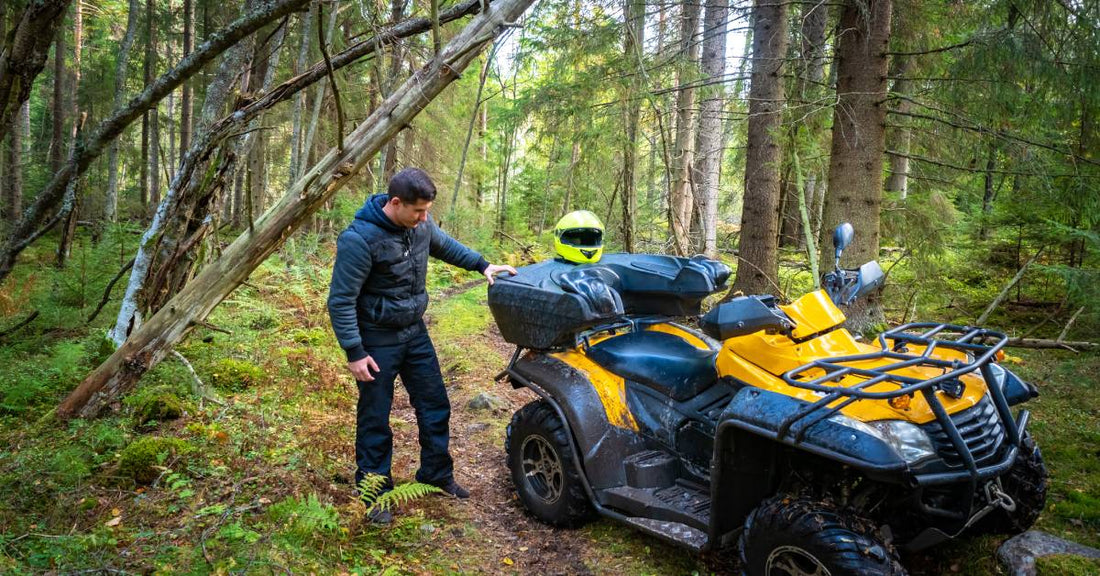You’re tearing through trails, wind rushing past, adrenaline pumping, but then… your ATV sputters and shuts off. There’s nothing more frustrating than mechanical issues cutting short the thrill of your off-road adventure. We’ll break down what to know about the common culprits behind these abrupt stops so you can determine why your ATV keeps shutting off.
Contaminated Fuel
One of the simplest problems could be a contaminated fuel tank. Even if it has fuel, it could be contaminated with water, dirt, or other impurities, causing your engine to stall. Contamination can lead to blockages in the fuel filter or carburetor and disrupt the smooth flow of fuel to the engine. Regularly checking and replacing the fuel filter can prevent dirt and debris from wreaking havoc. Make it a habit to use high-quality, clean fuel to keep your ATV humming.
Dead or Weak Battery
Battery problems are other common reasons for ATVs shutting off. A dead or weak battery can prevent your ATV from starting or staying operational, particularly when using electrical accessories. Loose or corroded battery connections can also disrupt the power flow and cause intermittent shutdowns.
You can do the following maintenance tasks to keep the battery in good condition:
- Securely mount the battery to prevent movement and vibration damage.
- Regularly inspect the battery terminals and connections for corrosion.
- Clean buildup off the battery terminals with a mixture of baking soda and water.
- Add distilled water to a lead-acid battery following the manufacturer’s instructions.
- Use a battery tender or trickle charger when the ATV is not in use to maintain a charge.
- Replace the battery every few years or as recommended by the manufacturer.
Ignition System Problems

Your ATV’s ignition system is crucial for starting and maintaining engine operation. A faulty spark plug or ignition coil can interrupt this process. A spark plug that’s worn out or covered in carbon buildup won’t ignite the fuel-air mixture effectively, causing the engine to shut off. Similarly, a damaged ignition coil can fail to produce the necessary spark to keep your ATV running.
Maintaining your ignition system involves regular inspection and replacement of spark plugs and ignition coils as needed. Check the maintenance schedule in your owner’s manual to determine when you should replace these parts. Also, ensure connections are secure and free from corrosion, as these problems can impede electrical flow.
Overheating
When temperature sensors detect abnormally high engine temperatures, they may trigger an automatic shutdown to prevent further heating. A lack of proper cooling, such as inadequate airflow to the radiator, can cause the engine to overheat. A leaking coolant system or a faulty thermostat can also prevent the engine from staying cool.
To avoid overheating, make sure your ATV’s radiator is free of mud or debris. You can install a rad kit to elevate the radiator and improve airflow. Regularly check coolant levels, and inspect hoses for leaks or cracks. Finally, using the manufacturer-recommended coolant mixture for your ATV model can enhance cooling efficiency and prevent overheating.
Carburetor Issues
The carburetor mixes air and fuel in the correct ratio for combustion. It regulates the flow of air and fuel into the engine for optimal performance and power delivery. A clogged carburetor disrupts the fuel-air mixture necessary for the engine to run smoothly. Luckily, regular maintenance and cleaning can prevent clogs and keep your ride running smoothly.
Improper adjustment of the carburetor can also cause engine shutdowns. If the mixture is too rich or too lean, the engine may stall unexpectedly. Consult your ATV’s manual or seek professional help to adjust the carburetor.
Transmission or Gear Shift Problems
Transmission issues can lead to unexpected ATV shutdowns by disrupting power delivery to the wheels, causing the vehicle to lose momentum and stall. Slipping gears, lack of engagement, or transmission fluid leaks can result in drivetrain malfunctions that impede forward movement and trigger a shutdown for driver safety.
Another common issue may occur with the gear shift mechanism itself. If not functioning correctly, it may cause the engine to stall. Ensure that the gear shift is in proper working order by regularly inspecting and servicing it as needed.
Electrical Damage

Electrical problems, such as a blown fuse or wiring issues, can also cause your ATV to shut off unexpectedly. Fuses protect your ATV’s electrical components from surges, and a blown fuse interrupts power flow. Damaged or loose wiring can cause intermittent electrical failures and engine shutdowns.
Inspect the fuses regularly, and replace damaged ones. Check your ATV’s wiring harness for frayed, damaged, or exposed wires, and secure all connections to prevent electrical interruptions.
Safety Switches Triggering Shutdown
ATVs have various safety switches to protect the rider. They can sometimes trigger a shutdown if the systems detect issues like improper seating or faulty connections. For example, O2 sensors measure the oxygen levels in the exhaust gases to help the engine control unit (ECU) adjust the air-fuel mixture for combustion. A faulty O2 sensor might trigger a shutdown if it malfunctions and sends inaccurate data to the ECU, leading to incorrect air-fuel mixture adjustments.
Installing an O2 delete sensor will bypass the oxygen sensor. This modification can be particularly popular with riders who want to avoid engine performance issues in wet environments where water or mud can disrupt sensor readings.
Air Intake or Exhaust System Blockages
Blockages in the air intake system can suffocate the engine, causing it to shut off. Debris or dirt can accumulate in the air filter and reduce the airflow necessary for combustion. Regularly checking and cleaning the air filter can prevent such issues and keep your ATV performing at its best.
Similarly, exhaust system blockages can create back pressure that negatively affects engine performance. If the exhaust is blocked, the engine can’t expel gases efficiently, leading to stalling. Inspect the exhaust system periodically for obstructions, and clear them to maintain optimal performance.
Promptly address potential issues with fuel, ignition, battery, and cooling systems to keep your ATV running smoothly. Regular maintenance, such as cleaning filters and checking connections, can mitigate many problems that cause sudden shutdowns. Follow these tips to minimize interruptions during your off-road adventures.

